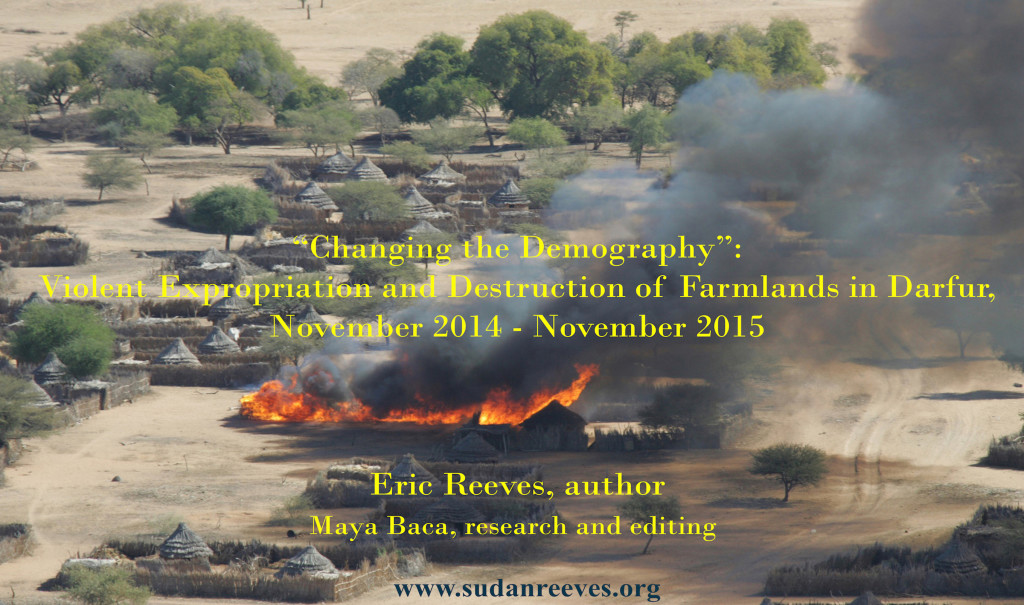“Changing the Demography of Darfur,” a briefing to UN Delegations, UN/Palais des Nations, Geneva | December 2, 2015
~ Eric Reeves, Genocide Prevention Advisory Network
I’ve worked for almost seventeen years as a Sudan researcher and analyst and have watched with horror as genocide in Darfur has continued to unfold over the past twelve years—and with renewed horror as ethnically-targeted violence has escalated over the past two years and more—again targeting, overwhelmingly, non-Arab or African farmers. We know far too little about what is occurring on the ground, this because of the silence Khartoum has enforced upon humanitarians and the total embargo on independent news reporting. But the third “dry season offensive,” announced by Khartoum’s political and military leadership, is well underway, and the consequences are simply shocking.
In my most recent Darfur work I have relied on the important research of Human Rights Watch, which reported earlier this year on the mass rapes of more than 220 girls and women in Tabit, North Darfur in 2014; the rapes were committed on orders from the commanding officer of the local garrison. More recently, Human Rights Watch has reported on the character of the Rapid Support Forces, now the primary militia force deployed by Khartoum in Darfur, working in concert with the regular Sudan Armed Forces. One moment in particular stands out in this report.
According to a defecting militiaman—speaking with the lead Human Right Watch investigator—in December 2014 Sudanese Vice President Hassabo Mohammed Abdel Rahman exhorted SAF regular troops and RSF militiamen in North Darfur:
“Hassabo told us to clear the area east of Jebel Marra…to kill any male.”
“He said East Jebel Marra is the kingdom of the rebels.”
“We don’t want anyone there to be alive.”
“He said we want to clear the area of insects…”
This is a more explicit and detailed reprise of a memorandum emanating from the Misteriya, North Darfur headquarters of the notorious Janjaweed leader Musa Hilal in August 2004:
“Change the demography of Darfur; empty it of African tribes.”
The evidence of the past year makes clear that Vice President Hassabo’s words were taken seriously. I have created a data spreadsheet documenting more than 500 atrocity crimes, most occurring in North Darfur (see below).
What the overwhelming majority of these crimes have in common is the violent expropriation and destruction of African farmlands. In the process, villages are comprehensively destroyed, as in the early years of the genocide; water points are seized; livestock are loosed on croplands, often as harvest approaches.
The 2.7 million internally displaced persons, who have often escaped to nearby camps, frequently try to return to cultivate their farms. Far too many of these ventures are marked by beatings, rapes, gang-rapes, and murder. A signal is being sent by the new Arab settlers or “owners” of the land: “this land is now ours—and if you or your family attempt to farm it, or use the water associated with it, or even gather straw and firewood, we will kill you, we will rape you.”
A similar message is delivered by Khartoum’s military aircraft—bombing fields, villages, and concentrations of livestock. In January of this year the UN Panel of Experts on Darfur reported that, “The effects of this [indiscriminate bombing campaign] have resulted in 3,324 villages being destroyed in Darfur over the five-month period surveyed by the Darfur Regional Authority, from December 2013 to April 2014.”
The “demography of Darfur” is indeed being changed—and by the most brutal and ghastly methods imaginable.
The atrocity crimes committed between November 2014 and November 2015 are concentrated in the East Jebel Marra region of North Darfur, around towns such as Tawila, Kakkabiya, and Tabit. But throughout Darfur new human displacement continues to be measured every year in the hundreds of thousands—2 million newly displaced since the UN/African Union hybrid force took up its civilian protection mandate in January 2008.
The violent expropriation of land, and violent control of arable and paturable land, is creating an insuperable obstacle to real peace, and yet such violence and expropriation are openly supported by Khartoum. Negotiations cannot succeed so long as this intolerable transfer of agricultural wealth is unaddressed. But instead of pressuring Khartoum to halt the process, the world has looked away.
With humanitarian indicators showing severe malnutrition, declining health and medical care, as well as deteriorating water and sanitation, the killing in Darfur is far from over. Extant data indicate that total morality related directly and indirectly to violence now exceeds 500,000. The dying is far from over; indeed it is accelerating rapidly.
[All materials relating to the issue of violent expropriation of African farmlands, and the nature of the atrocity crimes that define this violence, may be found here.]
